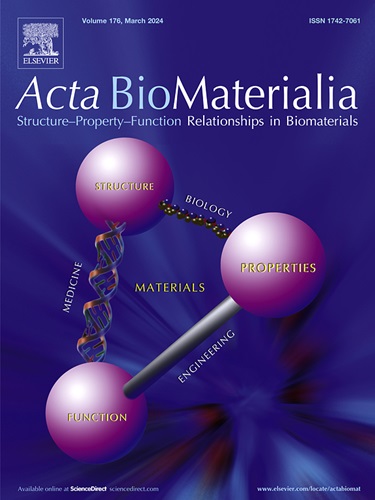Local characterization of collagen architecture and mechanical properties of tissue engineered atherosclerotic plaque cap analogs
IF 9.4
1区 医学
Q1 ENGINEERING, BIOMEDICAL
引用次数: 0
Abstract
Many cardiovascular events are triggered by fibrous cap rupture of an atherosclerotic plaque in arteries. However, cap rupture, including the impact of the cap's structural components, is poorly understood. To obtain better mechanistic insights in a biologically and mechanically controlled environment, we previously developed a tissue-engineered fibrous cap model. In the current study, we characterized the (local) structural and mechanical properties of these tissue-engineered cap analogs. Twenty-four collagenous cap analogs were cultured. The analogs were imaged with multiphoton microscopy with second-harmonic generation to obtain local collagen fiber orientation and dispersion. Then, the analogs were mechanically tested under uniaxial tensile loading until failure, and the local deformation (strain) and failure characteristics were analyzed. Our results demonstrated that the tissue-engineered analogs mimic the dominant (circumferential) fiber direction of human plaques. The analogs also exhibited a physiological strain stiffening response, similar to human fibrous plaque caps. Ruptures in the analogs initiated in and propagated towards local high-strain regions. The local strain values at the rupture sites were similar to the ones reported for carotid human fibrous plaque tissue. Finally, the study revealed that the rupture propagation path in the analogs followed the local fiber direction.
Statement of significance
Many cardiovascular events are triggered by mechanical rupture of atherosclerotic plaque caps. Yet, cap rupture mechanics is poorly understood. This is mainly due to the scarcity of plaques for high-throughput testing and the structural complexity of plaques. To overcome this, we previously developed tissue-engineered cap analogs. The current study characterizes (local) structural and mechanical properties of these cap analogs. Our findings show that: (1) cap analogs closely mimic human fibrous caps, including fiber orientation and strain stiffening responses; (2) structural and mechanical properties of cap analogs are associated, which provides critical information for understanding plaque rupture; and (3) cap ruptures commonly start in and propagate towards high-strain areas, indicating the potential use of strain measurements for cap rupture risk assessment.

求助全文
约1分钟内获得全文
求助全文
来源期刊

Acta Biomaterialia
工程技术-材料科学:生物材料
CiteScore
16.80
自引率
3.10%
发文量
776
审稿时长
30 days
期刊介绍:
Acta Biomaterialia is a monthly peer-reviewed scientific journal published by Elsevier. The journal was established in January 2005. The editor-in-chief is W.R. Wagner (University of Pittsburgh). The journal covers research in biomaterials science, including the interrelationship of biomaterial structure and function from macroscale to nanoscale. Topical coverage includes biomedical and biocompatible materials.
 求助内容:
求助内容: 应助结果提醒方式:
应助结果提醒方式:


